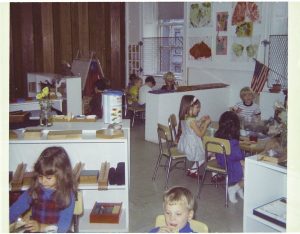The design of a Montessori classroom, sometimes referred to as the “Prepared Environment,” is an important component of the Montessori method of education. In each Montessori classroom, the furniture and learning materials are scaled to the child. To make learning materials inviting to the child, the teacher stores them in places that are visible and easily accessible to children. Room to Learn, filmed in 1968 at the Early Learning Center in Stamford, Connecticut, describes the design and construction of a Montessori school and explains the layout of a Montessori classroom. That same year, AMS member Jane Nielson photographed Montessori classrooms all over the country. Many of the classroom elements described in “Room to Learn” are visible in her photographs.
The UConn Library is committed to making our collections fully accessible, but some older media, such as the video shown here, do not allow us to provide captions or transitions on this webpage. Contact the staff at archives@uconn.edu to ask for a transcript of this video.
In “I Can Do It Myself,” which appeared in the AMS periodical, The Constructive Triangle, Volume VI, Number 3 (Summer 1979), Eileen S. Adler explains the importance of the prepared environment to the development of a child’s independence. She notes, “If we want our children to be independent and feel that they can do it themselves, we must provide the environment that allows them this space.” Scaling the classroom to the child encouraged independent action by making activities easier for children to complete on their own and made work more comfortable. Maria Montessori explained this feature of the prepared environment in her book, Spontaneous Activity in Education (Originally translated into English in 1917):
“It is the tendency of the child actually to live by means of the things around him; he would like to use a washstand of his own, to dress himself, really to comb the hair on a living head, to sweep the floor himself; he would like to have seats, tables, sofas, clothes-pegs, and cupboards. What he desires is to work himself, to aim at some intelligent object, to have comfort in his own life. . . . We offer a very simple suggestion: give the child the environment in which everything is constructed in proportion to himself, and let him live therein.”
Montessori classrooms across the United States followed this model, with low shelves that were easily accessible to students and chairs and desks that were sized to fit the child.



